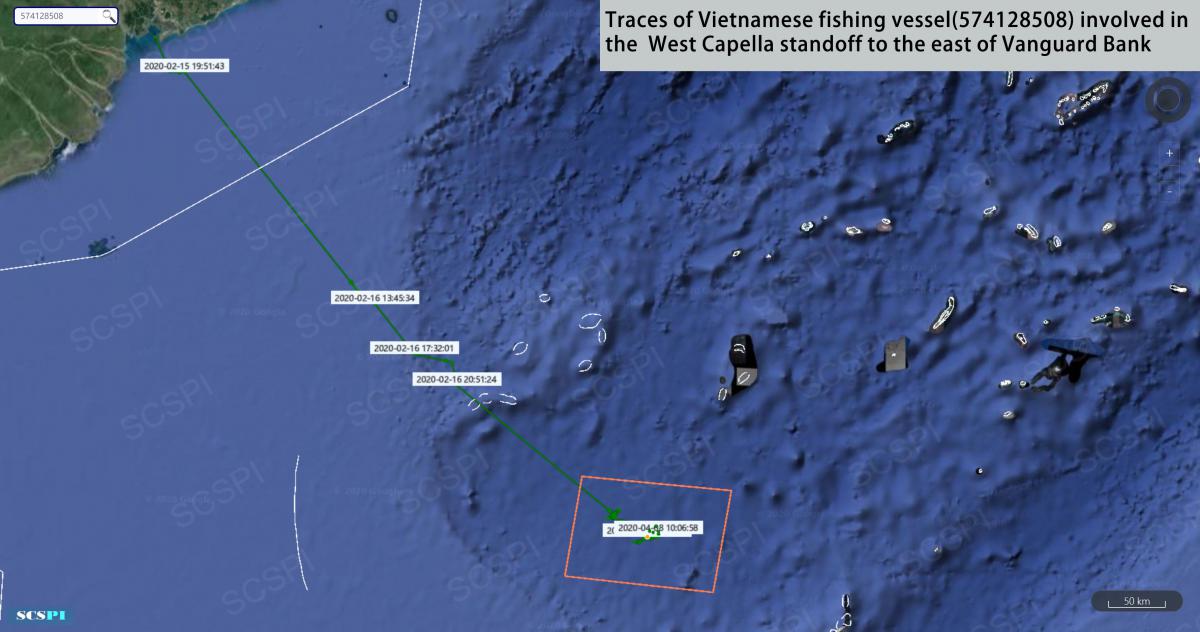Militias are common among countries like the United States and China. But in a world where the modernization of national defense and military professionalization are on the rise, it is very rare for a country to place equal emphasis on both militias and regular armies in the way Vietnam does now, especially during peacetime.
Even though many countries still have the concept of militias, they function more of a tradition or a symbol. In Vietnam, however, the system is quite different and the role of militia is even strengthening. Specifically, Vietnam’s Militia is considered a crucial component of its national defense which not detached from production and work. By the end of 2019, the Vietnam’s Militia accounted for 1.44% of the country’s total population, which is approximately 1.5 million people.
The maritime militia is a mobile force deployed by the Vietnamese government to its illegally occupied islands and claimed waters. It engages in fishing and production as well as the maritime security tasks assigned by the Vietnamese government. Vietnam implements a “Maritime Militia” system in Paracel Islands and other waters in the South China Sea, which integrates fishing activities into its military security framework and takes fishing vessels (fishermen) as “forward-deployed forces” when dealing conflicts over the South China Sea with Malaysia and China. Many observers believe Vietnam’s illegal activities has become a regional headache, as it has clashed with multiple countries including China, Indonesia, Malaysia, and France over this issue.
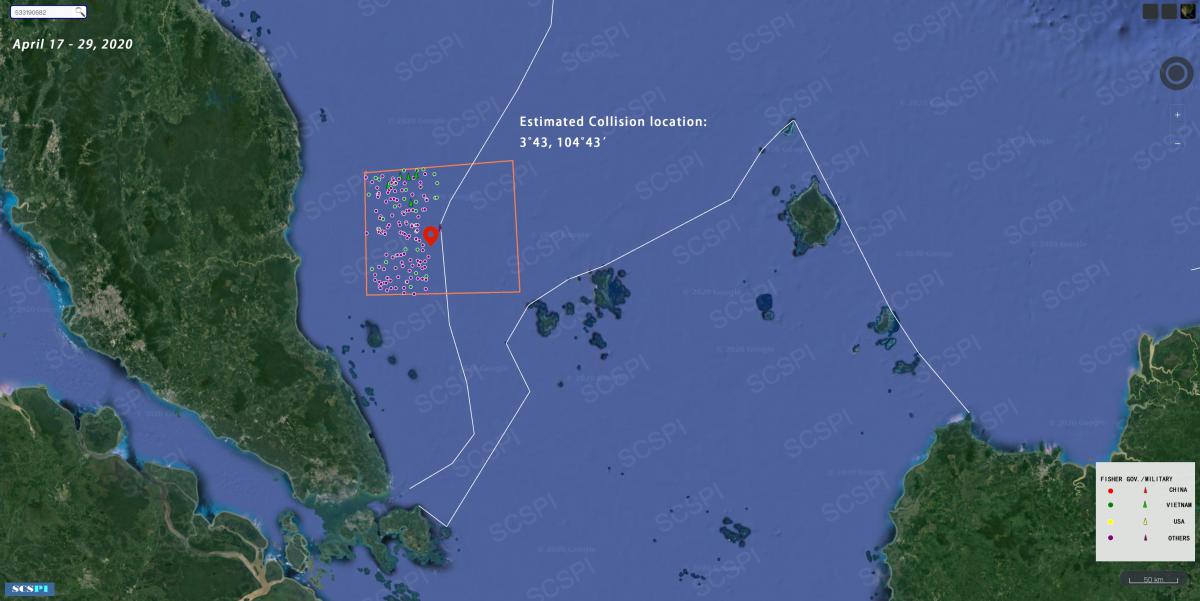
Estimated collion location of the April 19 incident
Vietnamese IUU has become a regional concern. On Apr 19, three Vietnamese vessels conducted IUU in the boundary waters of Malaysia and Indonesia, one collided with Indonesian law enforcement ship, two were detained, and four fishermen were missing.
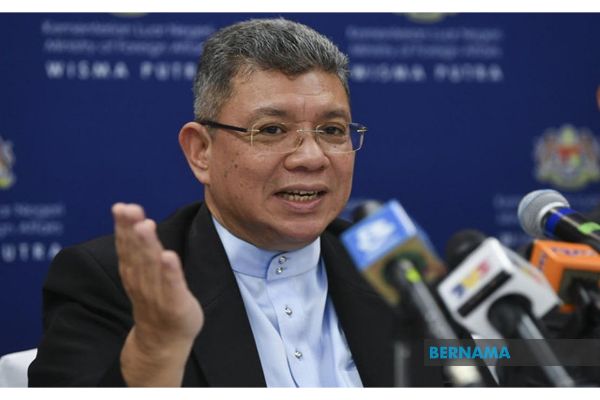
According to an interview with Malaysian Foreign Minister lately, 141 Vietnamese fishermen were detained by Malaysia last year for IUU fishing.
Simply viewing such Vietnam’s activities as common illegal, unreported and unregulated (IUU) fishing clearly cannot account for its nationwide compulsory military service and irregular maritime activities. Various evidences show that Vietnam’s political and security concerns behind those fishing activities in the South China Sea warrant more attention than its economic pursuit.
Vietnam’s Maritime Militia System
Vietnam’s Militia is comprised of the core militia and general militia, based on different management systems and tasks, according to the 2009 Law on Militia and Self-Defense Forces. Subject to regular training and military management, the maritime militia belongs to the core militia. The 2019 revised version stipulates that the militia consist of the mobile militia, permanent militia, maritime militia, and special militia(executing tasks like artillery, engineering, reconnaissance, communication, etc.) This in effect includes all militia under the management of the core militia. According to Vietnamese law, except for special circumstances, all Vietnamese citizens (male aged 18-45, and female 18-45) are obliged to join the militia for a service of four to six years.
The latest Law on Militia and Self-Defense Forces defines the militia as a component of the People’s Armed Forces of Vietnam, which is under the leadership of the Ministry of Defense and the command of the Minister of National Defense with the Chief of the General Staff of the People’s Armed Forces as the commander-in-chief. At the sub-central level, there are military commands at districts, towns, or provincial cities with commanders responsible for executing the superior instructions. The management hierarchy of militia is as follows: group, squad, platoon, company, flotilla, battalion, and fleet. In recent years, Vietnam has constantly adjusted the organization of its maritime militia accordingly with changing situations at sea. Militia in key defense and security communes are organized into permanent militia platoons with complete duty schedules and organizations, prepared for instant combat. Meanwhile, the Vietnamese government has also paid special attention to a number of new models such as building a maritime militia squadron and militia posts at the land border to interact with habitation. Their scattered deployment allows flexibility and increases the efficiency of mobilization, command, and operation in emergencies.
The Law on Vietnam’s Militia and Self Defense Forces stipulates that the militia shall coordinate with the border guard, navy, air force, police units and other forces in defending national sovereignty and border security. Specifically, the maritime militia is responsible for protecting the sovereign rights and jurisdiction over Vietnam's claimed waters and islands. Given the activities of militia in Quang Ninh and other coastal regions, the Vietnam’s maritime militia not only engage in regular rescue missions, but also join the border and coast guards in operations such as, regular patrolling, monitoring and expelling foreign ships entering Vietnam’s claimed waters and timely reporting abnormal situations to their superiors, and propagating and mobilizing fishermen to execute special tasks and other maritime operations.
According to some local and maritime practices in Vietnam, the strict regime of maritime militia comprises two modes of operation: the core militia stationed on ordinary fishing vessels guide and organize the fishermen to engage in tasks of military security other than fishing activities; or they disguise themselves as ordinary fishing vessels to carry out special tasks among other ordinary ones.
Take the town of CUA VIET in Quang Tri Province as an example of Vietnam’s maritime militia combining military tasks with fishing. The town selects male fishermen or local laborers for training at sea, including three routes, namely shore, longshore and open sea, to build militia platoons. The owners or captains of the vessels in particular are selected to join the militia or be appointed as low-level commanders. In actual open sea fishing activities, militia fishing vessels boarded with three to five fishermen, will disguised as ordinary fishing vessels and join other militia platoons or regular armed forces in conducting maritime operations. Statistics show that there has been one maritime militia platoon, three maritime militia squads, and nine maritime joint operation groups with 28 professional militias on board in this town, as of March 2020.
In fact, Vietnam’s fishing vessels in the South China Sea operate beyond the scope of normal fishing activities, and many cases show that there are special political agendas involved. As in the Paracel incident on April 2, 2020, both sides’ accounts suggest that the sunken vessel QNg 90617 TS continued to make dangerous maneuvers, even though a Chinese coast guard ship warned it to leave, and it eventually rammed a China Coast Guard ship. Meanwhile, according to the information released by Vietnam afterwards, there were at least two other Vietnamese fishing vessels, namely QNG 90399 TS and QNG 90929 TS, watching the clash calmly on the scene, and rapidly sending photos of the accident back to Vietnam. These Vietnamese vessels had not tried to elude China Coast Guard or escape as ordinary fishing vessels would, but worked closely together and moved in sync.
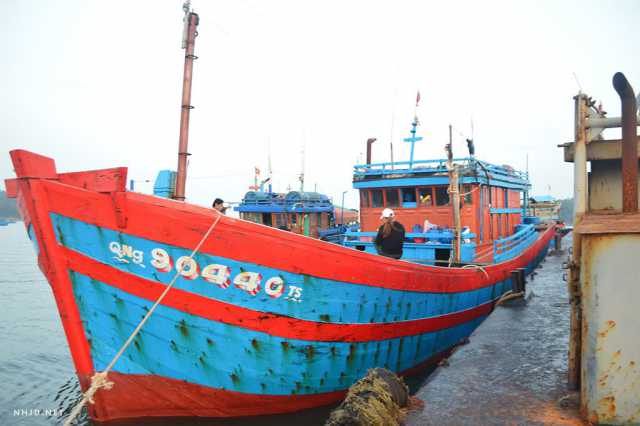
Vietnamese fishing vessel QNg 90440TS, source: http://www.nhjd.net/
Their persistent and organized operations testify that they are most likely not ordinary vessels but militia fishing vessels carrying out special maritime operations. Moreover, these three fishing vessels cannot be found in any database including MarineTraffic (marinetraffic.com) trusted by the Vietnamese, which shows that they are either not fishing vessels or have not registered with relevant international agencies, whichever is very suspicious.
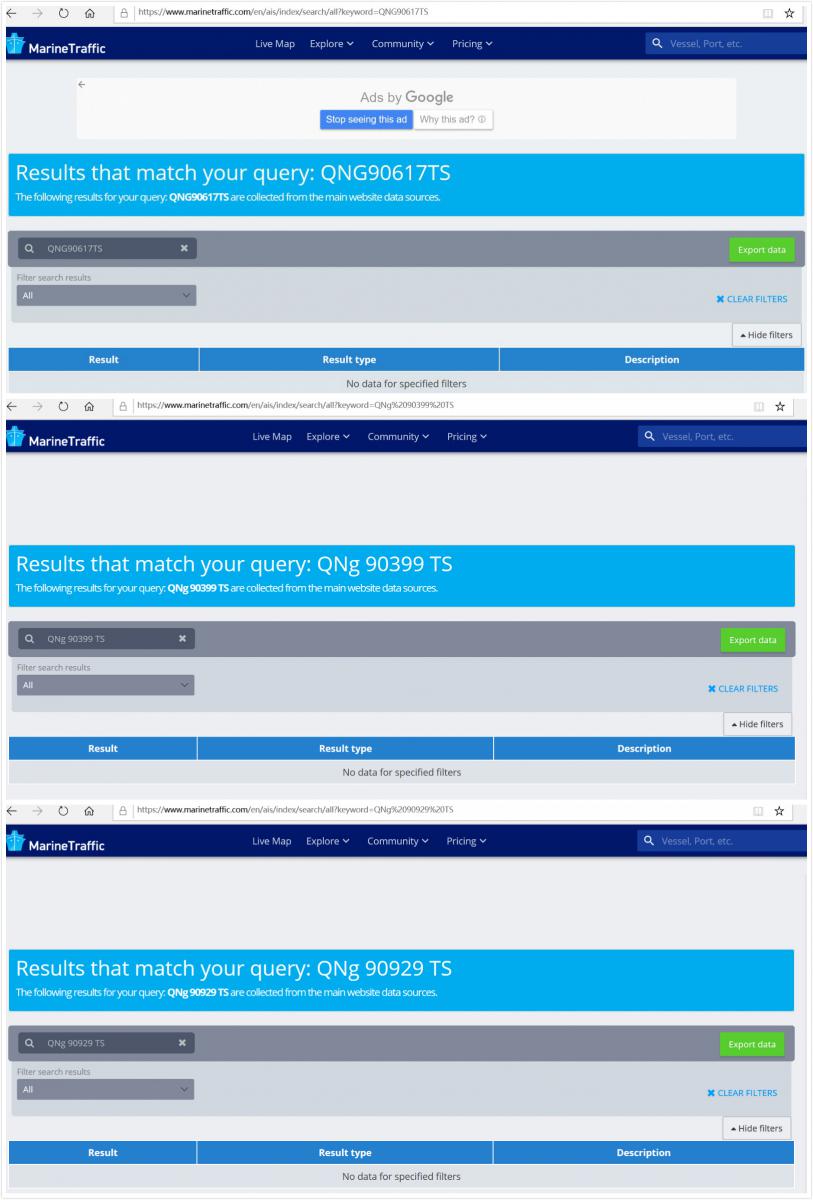
Three Vietnamese fishing vessels that have no records in marinetraffic.com
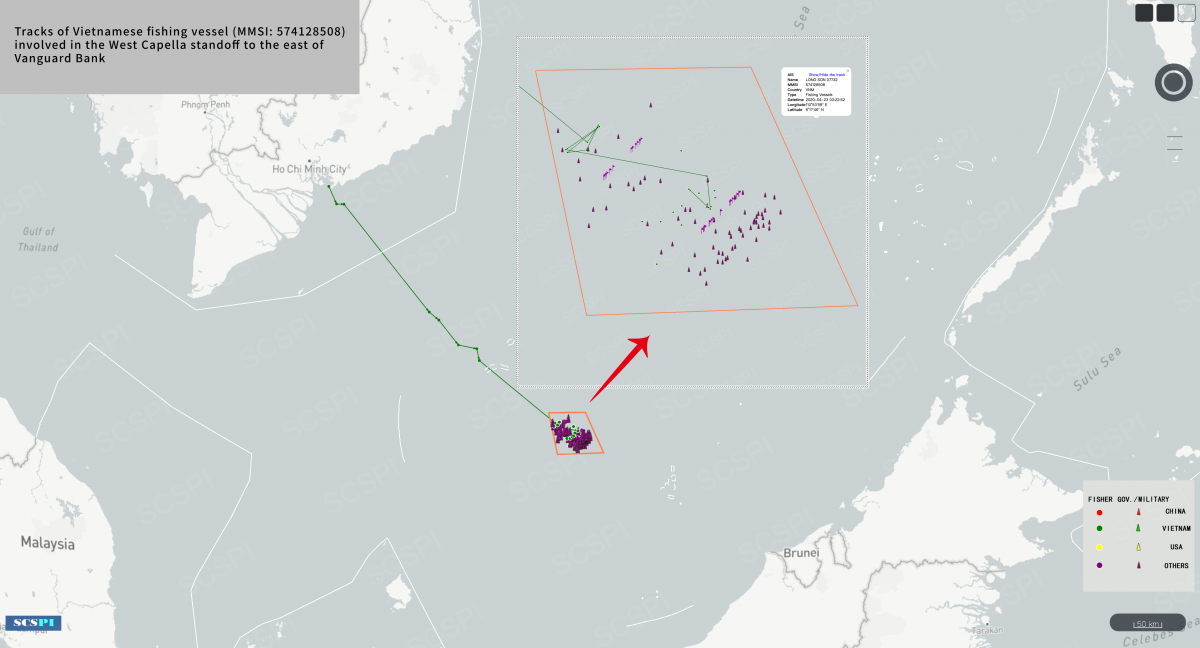
Long Son 07732 conducting surveillance operation near West Capella
Since October 2019, Vietnam has conducted quite a bit of surveillance with multiple militia fishing vessels near West Capella drilling rig, targeting Malaysia’s oil and gas exploration activities east of the Vanguard Bank of Spratly Islands. According to the information recorded by AIS, the Vietnamese vessel Long Son 07732 (MMSI: 574128508, length: 39m, width: 8m) supposedly registered as a fishing vessel has been conducting surveillance in Spratly Islands since it left its home port, the Vung Tau Port, south of Vietnam. On March 19th, 2020, the vessel was active around 6.46139 N, 111.05109 E, less than three nautical miles from the drilling ship West Capella rented by Malaysia operating at 6.43483 N, 111.07167 E.
Strengthened Vietnamese Maritime Militia Built on Battle Traditions
According to the Vietnamese government, the Vietnamese militia was founded in March 1935 (on what the Vietnamese call Tradition Day), with 85 years of history. During the Vietnam War (1954-1975), building on the fishery cooperatives in coastal provinces, the Vietnamese government mobilized many fishermen and armed soldiers to form the self-defense militia. The militia, armed with lightweight equipment such as 85mm artillery, together with the regular army, greatly distracted American forces.
After the unification of Vietnam, the government still saw the militia as an important part of its national defense and maintained its battle traditions. To better serve the country’s domestic and foreign interests, Vietnam’s militia have been adjusting its development direction and battle missions, gradually shifting to safeguarding domestic security and engaging in border and maritime issues.
Since 2010, as frictions grew with China, Malaysia, and Indonesia in the South China Sea, especially after the 2014 Standoff in the South of Triton island, Vietnam’s central and local governments have significantly ramped up efforts to strengthen its maritime militia by upgrading its personnel, organization structure and weapon supplies to better cope with maritime tensions.
In top-level design, Decree No. 04/CT-BQP of the Minister of National Defense on “The Guidance to Strengthening Building Militia Operating at Sea” released in 2007 has pushed forward the construction of militia. The following documents such as Decrees No. 67 /ND-CP and No. 89 /ND-CP of the Prime Minister, and Resolution No. 49 /QD-TTg of the Government have provided costal fishermen with funds and loans worth trillions of Vietnamese dongs to build high-power ships. According to Vietnamese public documents, when building steel vessels with a 400 CV main engine, or long-range fishing vessels with 800 CV, vessel owners can receive a loan covering up to 95% of costs, with an annual interest rate of 7%, of which 1% is paid by the owners and the rest of 6% are paid by the Vietnamese government.
In fact, practices in some coastal areas of Vietnam suggest that under the compulsory military service system, activities of Vietnam’s fishing vessels in the South China Sea prioritize military security missions. A high-ranking Vietnamese military officer stated that Vietnam is making every fishing vessel and fisherman a sovereign milestone of Vietnam’s sea areas and islands. Since 2014, Vietnam has been implementing a reinforced strategy, building up maritime militia nationwide. Up until early 2019, Quang Ninh Province had established a militia with over 1,100 members, most of whom are active in the South China Sea.
In Thuan Nam District, Ninh Thuan Province, the militia is mainly comprised of discharged soldiers, which has one standing militia platoon and two standing maritime militia squads within six high-power fishing vessels. In 2018 alone, a total of 99 people participated in the maritime military exercise. Since 2017, Thuan Nam District has organized 106 maritime joint operation groups (mostly on long-range operations), while practicing the strategy of employing the same fishing methods in the same fishing grounds with the same group of local residents. These groups collaborate with coast guards, border troops and fishing inspection departments to conduct special tasks including patrolling, surveilling foreign vessels and dealing with maritime electronic reconnaissance.
With the coordinated support of the central and local governments, Vietnam’s maritime militia and its vessels are rising, whose equipment and quality have also significantly improved. Based on fishing vessels, fishermen and production teams, coastal governments select politically loyal ones to form maritime militia platoons with financial support. As of October 2019, statistics from the European Parliament Committee on Fisheries (PECH), a keen watcher of Vietnamese fisheries, suggest that about 8,000 fishing boats and 1.22% of the country’s maritime labor forces are members of the maritime militia. Accordingly, given that Vietnam has more than 4.5 million people engaged in marine aquatic industry (670,000 of whom are engaged in aquaculture), the size of Vietnam’s maritime militia should be more than 46,000 people, accounting for 3% of the Vietnam’s militia.
However, the actual size of Vietnam’s militia could be much larger than the estimation. Vietnam’s marine aquatic industry population constitutes around 4.7% of its total population. With the Vietnamese government prioritizing extending maritime claims in recent years, the proportion of the maritime militia could even be higher than 4.7% with an estimated size of at least 70,000 people. To be more specific, a rough estimation shows that Vietnam has deployed 13 maritime militia platoons among the nearly 3,000 fishermen located near Paracel Islands. In southern Vietnam, around 10,000 fishermen and 2,000 fishing vessels have received military equipment.
The Decree No. 67/2014/ND-CP of the Prime Minister released in August 2014 stipulates that the government will provide a loan of approximately USD 400 million to support building new fishing vessels and upgrading old ones. Up until the first half of 2016, the State Bank of Vietnam had allocated USD 176 million in special loans to upgrade 400 high-power fishing vessels and build 84 new vessels. Up until September 2019, Vietnam had built 1,032 long-range fishing vessels, among which 362 are steel vessels, 571 are wooden, 99 are new material; and 37 are upgraded with the loans. Up until January 2019, Cua Viet Town alone had built 10 new steel fishing vessels and seven wooden vessels with a capacity of 800 horsepower or higher, investing a total of USD 11 million.
In response to the changing maritime situation, Vietnamese government has organized the coast guard and border troops to provide militia platoons with targeted trainings such as: deploying at sea, communicating methods, reporting on the maritime situation, identifying unfamiliar vessels, and fighting against foreign vessels. At the same time, Vietnam also trains its militia in professional radio operation so that they can conduct electronic reconnaissance at sea. With modern equipment, the high-power fishing fleet has greatly increased its capability to conduct reconnaissance and counter-reconnaissance. For instance, 33 fishing vessels in Thuan Nam District have been equipped with distance measuring equipment (DME), locators, radio equipment, and detectors, etc.
Complex Political Concerns Behind Vietnam’s Maritime Militia System
A myriad of political and security concerns are behind Vietnam’s massive maritime militia forces.
First of all, Vietnam uses its massive, widespread, and mobile fishermen (and fishing vessels) to extend maritime claims, especially to provoke “disputes” over Paracel Islands. Frequent and ongoing vessel (fishermen) activities have become a crucial way for Vietnam to reiterate its claims in the South China Sea to the international community. Since entering the 21st century, Vietnam, on the basis of its unilateral claims, has been sending fishing militia to Paracel Islands frequently. It would hype every accident in the waters such as crew falling overboard to create and sell the idea of sovereignty and jurisdiction disputes in Paracel waters to the world.
Secondly, for Vietnam, IUU fishing is a policy option which promises economic and political dividends and maximizes the benefit-cost ratio. Vietnam opts for arming fishermen with manageable fiscal subsidies instead to compete against other claimants with its regular military forces. In this way, Vietnam can strengthen its claim with economic presence and support navy’s covert military operations with a much lower economic cost. At the same time, Vietnam’s disguised militia claim the “moral high ground” by painting a vivid picture where China employs its superior strength to face weak neighbors and “have the South China Sea to itself. " With Vietnam playing the victim, China’s hands are tied when dealing with the South China Sea issues.
Furthermore, by undermining China’s reputation, Vietnam hopes to foster a better environment to act unilaterally in Spratly waters. Given the military capacity gap between Vietnam and China, Vietnam’s strategy of playing the victim deliberately amplifies China’s power advantage, making China a “bully” at sea so that it can gain sympathy and support from the international community when it conducts unilateral activities in Spratly Islands such as island/reef fortification and oil/gas exploitation.
Conclusion
The Vietnamese government is strengthening its strategy of “nationwide maritime militia” and working very hard to incorporate all of its fishing vessels (fishermen) in the South China Sea into the guidance of its national defense department by attaching great importance to or even prioritizing maritime militia in dealing with maritime issues. With its maritime militia system, Vietnam can impede China’s operation in the South China Sea to the greatest extent, weaken China’s international reputation, worm international support with a very low cost, and seize initiative in maritime disputes with Malaysia and Indonesia. In the context of intensified Sino-US power competition in the South China Sea, Vietnam has seemingly reaped great benefits from the “maritime militia” strategy: Not only can Vietnam monitor China and extend its claim in the South China Sea (Paracel Islands in particular), but also can it rely on the US in conflicts with China.
However, Vietnam’s “maritime militia” strategy has left a huge “black hole” for all parties when dealing with the South China Sea issues. Meanwhile, it also creates potential risks for the regional prospect, presents difficulties in Code of Conduct consultation, and runs counter to the current trend of military and civilian differentiation.

